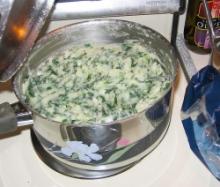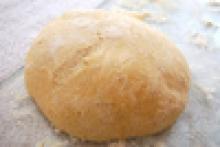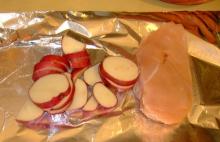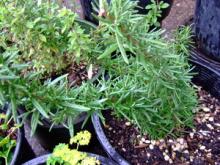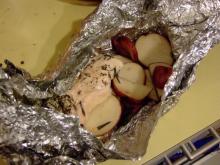Colcannon
Well did you ever make colcannon,
made with lovely pickled cream
With the greens & scallions mingled
like a pitcher in a dream
Did you ever make a hole on top
to hold the meltin' flake
Of the creamy flavoured butter
that our mother's used to make
Even if you aren't Irish,
you might know the song "Colcannon," popularized in the U.S by Mary Black. In the song, the joys of Colcannon, a dish made of mashed potatoes, cabbage (or kale), scallions, and butter (lots of butter!) are celebrated. Colcannon was a staple for rural Irish families, since it used ingredients that were local and readily available, and quite affordable. If you were lucky, you might have a bit of good Irish bacon to saute with the scallions and serve to season the dish.The name colcannon derives from the Irish cál ceannann, cál, cognate with English kale, both borrowed from Latin caulis or "cabbage," with the compound ceann, head , from Old Irish cenn, plus the lenited (the f is dropped) or "white," for a phrase that means "white-headed cabbage."
In the most basic, traditional form, Colcannon is made from mashed potatoes, kale (or cabbage, but since I much prefer it with kale, I'll be talking about kale here), butter, salt, and pepper. Depending on the cook, and how you make mashed potatoes, colcannon can be made with other ingredients like milk (cream), leeks, onions, chives, garlic, boiled ham or Irish bacon. Although it's most frequently made in the fall, when kale is plentiful, there's no reason it has to be an autumn dish. I note that the more traditional recipes call for huge quantities of butter; feel free to adjust to suit your taste. Garlic is a nice addition, but it is not one that's traditional.
My preferred method involves boiling the potatoes (steaming works well too), with the skin on or off to suit local preferences. I then mash the potatoes with milk or a bit of heavy cream, butter, and salt and pepper while I cook the kale either by steaming it or blanching it for a minute in rapidly boiling salted water. I saute the bacon and scallions (or leeks or onions) in a bit of butter, then chop the kale (go ahed and use a food processor if you have one), and stir the kale and the seasoned scallions into the mashed potatoes.
Serve the colcannon with a small well or depression in the top to hold a pat of melting butter, or melt butter to drizzle into the depression before serving. It's lovely accompanied by Guinness.
For alternative recipes, see here, here and here, or watch the video here.
